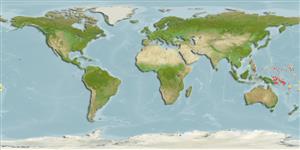Classification / Names
Common names | Synonyms | Catalog of Fishes (gen., sp.) | ITIS | CoL | WoRMS | Cloffa
Actinopterygii (ray-finned fishes) >
Perciformes (Perch-likes) >
Pomacentridae (Damselfishes) > Pomacentrinae
Etymology: Chromis: Greek, chromis = a fish, perhaps a perch (Ref. 45335); abyssus: Name from Latin form of the Greek noun 'abyssos' meaning abyss, for the documentary film Pacific Abyss, produced by the British Broadcasting Corporation (BBC), which funded the expedition on which the type specimens were collected.
Environment / Climate / Range
Ecology
Marine; reef-associated; depth range 107 - 150 m (Ref. 90102). Tropical, preferred ?
Western Pacific: Palau.
Size / Weight / Age
Maturity: Lm ? range ? - ? cm
Max length : 9.8 cm SL male/unsexed; (Ref. 59379)
Dorsal
spines
(total): 14;
Dorsal
soft rays
(total): 12-13;
Anal
spines: 2;
Anal
soft rays: 12 - 14. This species is distinguished by the following characters: Dorsal rays XIV,12-13, usually 13; anal rays II,12-14, usually 13; pectoral rays 18-19, usually 19; spiniform caudal rays 3; tubed lateral-line scales 14-16; gill rakers 6-7 + 17-18, usually 7 + 18, total 24-25, usually 25; body depth 1.58-1.83 in SL; the color when fresh is dark gray with a large iridescent dark blue spot at center of each scale; membranes on median fins and pelvic fins opaque charcoal gray, with an iridescent dark blue margin on the spinous part of the dorsal and anal fins; caudal fin mottled iridescent dark blue and black; pectoral fins with a black ovoid spot covering the basal portion and pectoral-fin axis (Ref. 59379).
Adults appear to prefer depths more that 115 m, staying close to the substratum, sand and rubble slope with boulders and rock outcroppings. They take refuge in small caves and holes. Juveniles and some subadults were observed around limestone talus. Adults were usually solitary or in pairs, while subadults and juveniles were seen in small groups. Oviparous, distinct pairing during breeding (Ref. 205). Eggs are demersal and adhere to the substrate (Ref. 205). Males guard and aerate the eggs (Ref. 205). Other Chromis associated with this species include C. brevirostris, C. degruyi and C. earina (Ref. 59379).
Life cycle and mating behavior
Maturity | Reproduction | Spawning | Eggs | Fecundity | Larvae
Oviparous, distinct pairing during breeding (Ref. 205). Eggs are demersal and adhere to the substrate (Ref. 205). Males guard and aerate the eggs (Ref. 205).
Pyle, R., J.L. Earle and B.D. Greene, 2008. Five new species of the damselfish genus Chromis (Perciformes: Labroidei: Pomacentridae) from deep coral reefs in the tropical western Pacific. Zootaxa 1671:3-31. (Ref. 59379)
IUCN Red List Status (Ref. 115185)
CITES (Ref. 94142)
Not Evaluated
Threat to humans
Harmless
Human uses
More information
ReferencesAquacultureAquaculture profileStrainsGeneticsAllele frequenciesHeritabilityDiseasesProcessingMass conversion
Tools
Special reports
Download XML
Internet sources
